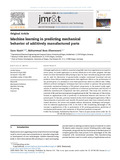Zitierlink:
http://dx.doi.org/10.25819/ubsi/10055Dateien zu dieser Ressource:
| Datei | Beschreibung | Größe | Format | |
|---|---|---|---|---|
| Machine_learning_in_predicting_mechanical_behavior.pdf | 3.8 MB | Adobe PDF |  Öffnen/Anzeigen |
| Dokumentart: | Article |
| Titel: | Machine learning in predicting mechanical behavior of additively manufactured parts |
| AutorInn(en): | Nasiri, Sara Khosravani, Mohammad Reza |
| Institut: | Fakultät IV - Naturwissenschaftlich-Technische Fakultät |
| Schlagwörter: | Desktop Manufacturing, Layer Manufacturing, Additive Manufacturing, 3D Print |
| DDC-Sachgruppe: | 670 Industrielle und handwerkliche Fertigung |
| GHBS-Notation: | ZHU |
| Erscheinungsjahr: | 2021 |
| Publikationsjahr: | 2022 |
| Auch erschienen: | Journal of Materials Research and Technology ; 14(2021), S. 1137-1153. - https://doi.org/10.1016/j.jmrt.2021.07.004 |
| Zusammenfassung: | Although applications of additive manufacturing (AM) have been significantly increased in recent years, its broad application in several industries is still under progress. AM also known as three-dimensional (3D) printing is layer by layer manufacturing process which can be used for fabrication of geometrically complex customized functional end-use products. Since AM processing paramet... |
| Beschreibung: | Finanziert aus dem Open-Access-Publikationsfonds der Universität Siegen für Zeitschriftenartikel |
| DOI: | http://dx.doi.org/10.25819/ubsi/10055 |
| URN: | urn:nbn:de:hbz:467-21324 |
| URI: | https://dspace.ub.uni-siegen.de/handle/ubsi/2132 |
| Lizenz: |  Creative Commons BY-NC-ND 4.0 Creative Commons BY-NC-ND 4.0 |
| Enthalten in den Sammlungen: | Geförderte Open-Access-Publikationen |
Diese Ressource ist urheberrechtlich geschützt. |


